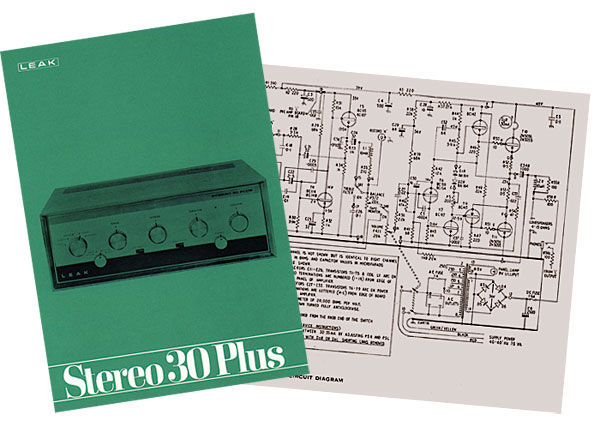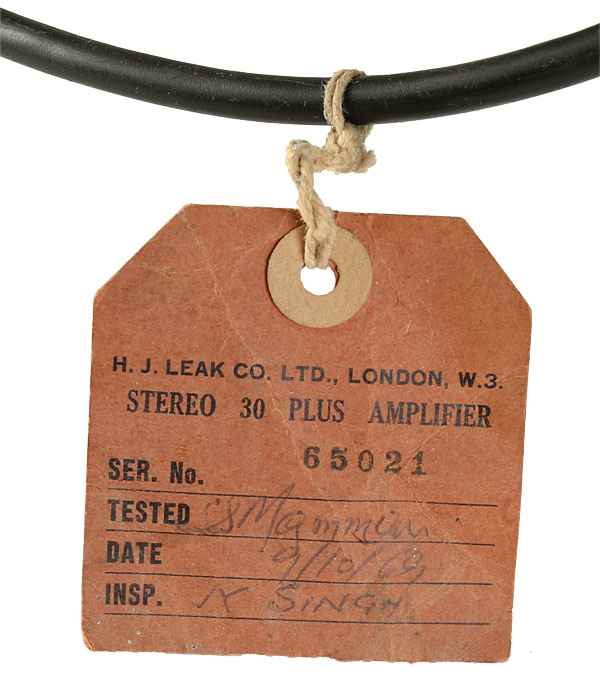Leak Stereo 30 Plus amplifier Page 2
Straight Talking
The 'Tape Replay' input is perhaps the most intriguing. When selected with the main switch this gives a sensitivity of 400mV, similar to that of the amp's 'Tuner 2' input. However, there is also a 'Tape Monitor' switch that routes the same socket straight through to the volume control, bypassing the preamp circuitry entirely. Since the gain of the preamplifier is nominally unity in this mode this action has no effect on the amplifier's output level, but noise obviously falls and overloading the input stage becomes impossible. The amp then essentially becomes a passive preamp driving a fixed gain power amp, as is the modern practice.
A corollary of this arrangement is that the tone controls no longer have any effect, but in all cases they do affect the recording output. Care is therefore needed to return the tone controls to their neutral settings before making a recording.

Compared to the possible confusion over inputs, the output side of the amplifier could not be simpler. There is one set of loudspeaker sockets and a headphone socket. In some early examples, such as our review sample, inserting a headphone jack does not mute the loudspeakers, the extra switching to do this only being added later. To keep the amplifier looking neat, a blanking plug topped off with a knob to match the stereo/mono selector at the other end of the panel was fitted to the headphone socket, although these are usually missing by now.
![]() Tim Listens
Tim Listens
The original Stereo 30 always impressed me with its gutsy and surprisingly powerful sound, which belies its germanium content and early '60s origins. I'm glad to say that the Stereo 30 Plus improves on this, the two versions sounding essentially similar with the 'Plus' having a bit more 'go' and a little less noise. Both have me wondering why Stereo 20s are so expensive when either of the '30s can still be had for relative pocket money.
In the end it's a question of distortion. That produced by the Stereo 20 tends to sharpen up the sound while that made by the 30 Plus makes it diffuse around the edges, something which is compensated for by an improved sense of bass accuracy and enough extra drive to make loudspeaker selection less of an issue.
The amplifier also sounds impressively transparent when used in 'Tape Monitor' mode, as one would expect since there are just six transistors in each channel between the source and the speakers when it's set up like this. However, in the spirit of assessing the design as a whole I stuck to the conventional inputs, using 'Tuner 2' and 'Pickup 1' as appropriate.

Listening to a varied selection of orchestral excerpts from a high-quality test disc [Test Sample 5; Philips 814 125-2] revealed the Leak Stereo 30 Plus to be a slightly warm-sounding amplifier, yet one capable of good extension in both the bass and treble regions. The low notes are rich and plummy and the highs have greater sparkle than one might expect from such a vintage design. Listening to Tchaikovsky's 'Waltz of the Flowers' from the Philips test CD and being critical, one could say that its low-end is perhaps a tad ponderous, but the pleasingly brisk top keeps things moving along and effectively counters this, making for a lively and engaging performance overall.
The amplifier was able to portray a reasonable sense of space and depth too. It isn't class-leading, but it's certainly respectable enough. Rock music failed to highlight any serious shortcomings in the presentation either. REM's delightful but raucous 'Bad Day' from the In Time compilation [Warner Bros 9362-48381-2] retained much of its bite and edge through the slightly soft-focus lens of the Stereo 30 Plus.

What's more, reasonable levels could be achieved before the onset of subjectively obvious break-up, something whose effect seemed to build gradually as the level increased rather than appearing suddenly when a threshold was crossed.
Finally, a run through of Lionheart by Kate Bush [EMI CDP 7 46065 2] revealed sweet if slightly recessed vocals. The dreamy atmosphere of the recording was rendered beautifully by the Stereo 30 Plus, the slight coloration which it adds being beneficial on this occasion. This is a surprisingly easy amplifier to live with, an important piece of British audio history that is simple to use and good to listen to.
Buying Secondhand
Finding a Stereo 30 Plus today is not difficult and they remain inexpensive. Therefore, one can afford to be choosy and disregard examples with worn fascias, missing knobs or previous modifications. It is best to choose one with the original wooden cabinet sleeve as the cardboard covers of the chassis model are not nearly so attractive.

Destruction of the output transistors can occur if the edge connectors at the bottom of the power amp modules fail to make good contact or if the bias preset controls fall apart. Excessive noise, rising in level with the setting of the volume control, is normally due to a defective transistor on one of the preamp PCBs. Complete silence from one channel in later models is often due to the speaker muting switch on the headphone socket, but this is easy to dismantle for cleaning.
Hi-Fi News Verdict
The Leak Stereo 30 Plus is an ideal introduction to vintage hi-fi being easy to find, cheap to buy and simple to repair. A well preserved example will return an enjoyable listening experience too, with little potential for expensive failure, though do take time to study the manual as doing so will ensure you get the best out of the amp. Partner it with the matching Leak Stereofetic tuner for an ideal way to enjoy BBC Radio 3.


















































